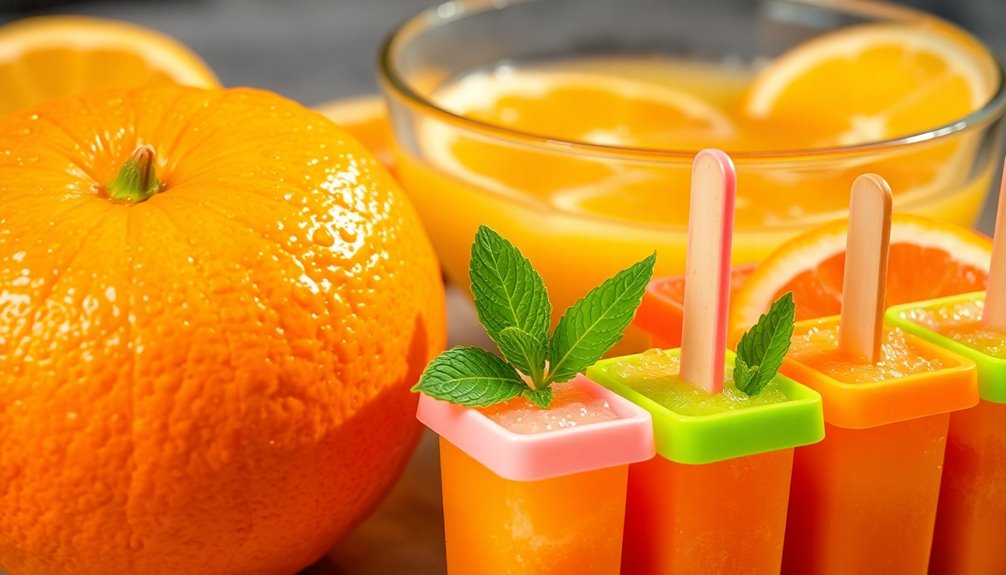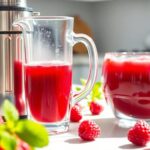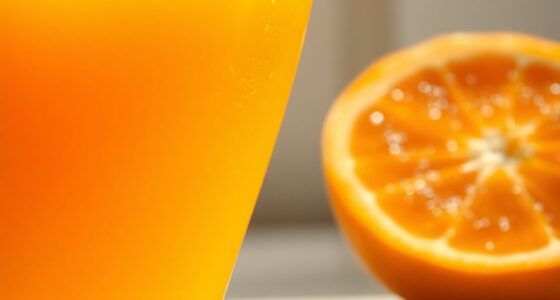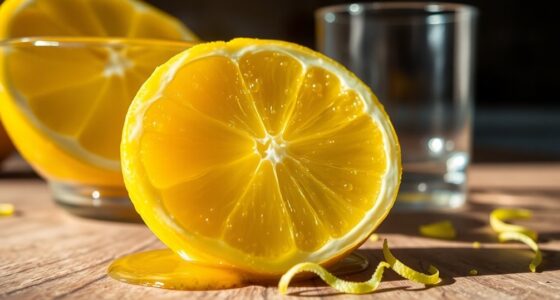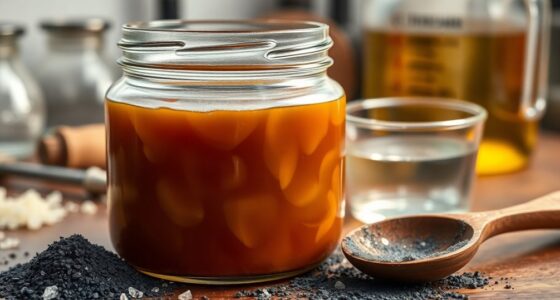To make refreshing orange juice popsicles, mix 3 cups of freshly squeezed orange juice with 1/3 cup of sugar, 1 tablespoon of lemon juice, and 1 teaspoon of vanilla extract until the sugar dissolves. Pour the mixture into popsicle molds, avoiding overfilling, and insert sticks if needed. Freeze for at least 4 hours until solid. To remove, run warm water over the molds. Store uneaten popsicles wrapped in plastic for up to 3 months. Discover more tips for perfect popsicles!
Key Takeaways
- Combine 3 cups of freshly squeezed orange juice, 1/3 cup sugar, 1 tablespoon lemon juice, and 1 teaspoon vanilla extract in a bowl.
- Stir the mixture until the sugar is completely dissolved for a smooth texture.
- Pour the mixture into popsicle molds, ensuring not to overfill them for expansion.
- Freeze the molds for at least 4 hours or until the popsicles are completely solid.
- To remove, run warm water over the molds for 20-30 seconds and store uneaten popsicles in a freezer-safe container.
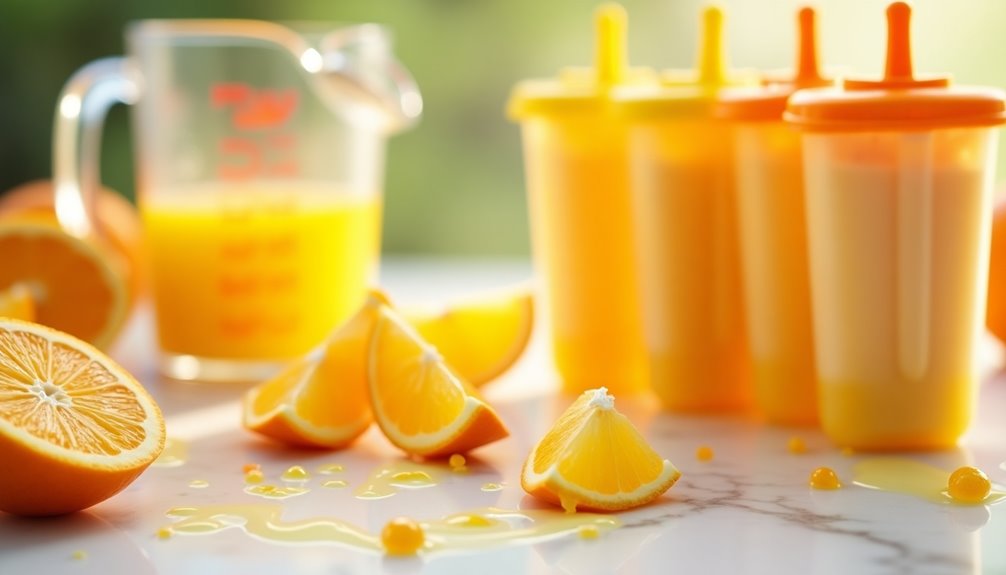
When you're craving a refreshing treat on a hot day, nothing beats homemade orange juice popsicles. These popsicles aren't only delicious but also a fantastic way to cool down while enjoying a burst of vitamin C. You'll love how simple and satisfying this orange popsicle recipe is, allowing you to whip up a batch of popsicles at home with minimal effort.
To start, gather your ingredients. You'll need 3 cups of freshly squeezed orange juice, 1/3 cup of granulated sugar, 1 tablespoon of lemon juice, and 1 teaspoon of vanilla extract. The combination of these ingredients creates a delightful flavor profile. The freshly squeezed orange juice serves as the star of the show, while the lemon juice gives a slight tang that complements the sweetness perfectly. The vanilla extract adds a subtle depth, making your popsicles taste like a gourmet treat.
Once you've got everything ready, it's time to mix. In a bowl, combine the freshly squeezed orange juice, granulated sugar, lemon juice, and vanilla extract. Stir the mixture until the sugar dissolves completely. This step is crucial because it ensures you won't have any grainy texture in your popsicles. You want a smooth, refreshing treat, after all!
Now that your mixture is ready, pour it into your popsicle molds. Make sure not to overfill them, as the liquid will expand as it freezes. If your molds don't come with sticks, insert popsicle sticks into each mold before placing them in the freezer. This part is easy to make and perfect for getting the kids involved. They'll love helping you pour the mixture and watching the popsicles take shape.
Next, you'll need to freeze the molds for at least 4 hours or until the popsicles are completely solid. Patience is key here, but the wait is worth it! After the freezing time is up, you'll be ready to enjoy your homemade popsicles.
To remove the popsicles from hard plastic molds, run warm water over the outside of the molds for 20-30 seconds. This helps loosen the popsicles, making it easier to pull them out without any breakage. If you have any uneaten popsicles, store them in a freezer-safe container or wrap them in plastic wrap for up to 3 months to maintain freshness.
Now you have a delightful treat that's easy to make and perfect for any hot day. With the right ingredients and a little time, you can enjoy delicious homemade orange juice popsicles that aren't only refreshing but also packed with vitamin C. So grab your popsicle molds and start creating your own frozen masterpieces!
Frequently Asked Questions
How Long Can Freshly Squeezed Orange Juice Be Frozen?
You can freeze freshly squeezed orange juice for up to 3 months while keeping its quality and flavor intact.
To do this, pour the juice into airtight containers or freezer bags, leaving some space for expansion.
Just remember, when you thaw it, the juice might lose some texture and separate, so it's a good idea to shake or stir it before using.
For the best taste, freeze the juice right after squeezing.
How Do You Make Popsicles Creamy and Not Icy?
To make your popsicles creamy instead of icy, incorporate full-fat coconut milk or heavy cream into your mixture.
Adding a bit of corn syrup or honey can help prevent those pesky ice crystals from forming.
Blend the mixture until it's smooth to introduce air, which lightens the texture.
Lastly, try using a higher sugar concentration to lower the freezing point, keeping your popsicles soft and deliciously creamy.
Enjoy experimenting!
How Long Does It Take to Freeze Juice Into a Popsicle?
It usually takes about 4 to 6 hours for juice to freeze into a popsicle, but this can vary based on your freezer's temperature and the size of your molds.
Make sure you fill the molds properly, leaving room for expansion.
If you're using hard plastic molds, running warm water over them after freezing can help release the popsicles.
What Ingredient Makes Popsicles Soft?
To keep your popsicles soft, sugar's your best friend. It lowers the freezing point of the mixture, preventing that rock-hard texture.
Aim for about 1/3 cup of sugar for every 3 cups of liquid. You can also substitute sugar with honey or agave nectar for a similar effect.
Adding a splash of lemon juice or mixing in fruit purées can enhance flavor and help maintain that delightful, soft consistency you're after.
Conclusion
As the saying goes, "When life gives you oranges, make popsicles!" Now that you've mastered the art of creating refreshing orange juice popsicles, it's time to enjoy your delicious treat. Whether you're cooling off on a hot day or looking for a fun snack, these popsicles are sure to brighten your mood. So grab your popsicle molds, experiment with flavors, and share your creations with friends and family. You've earned a sweet reward!
Cindy thoroughly researches juicing trends, techniques, and recipes to provide readers with practical advice and inspiration. Her writing style is accessible, engaging, and designed to make complex concepts easy to understand. Cindy’s dedication to promoting the advantages of juicing shines through her work, empowering readers to make positive changes in their lives through the simple act of juicing.

